Special Report
The Metro Area With the Worst Child Poverty Rate in Every State
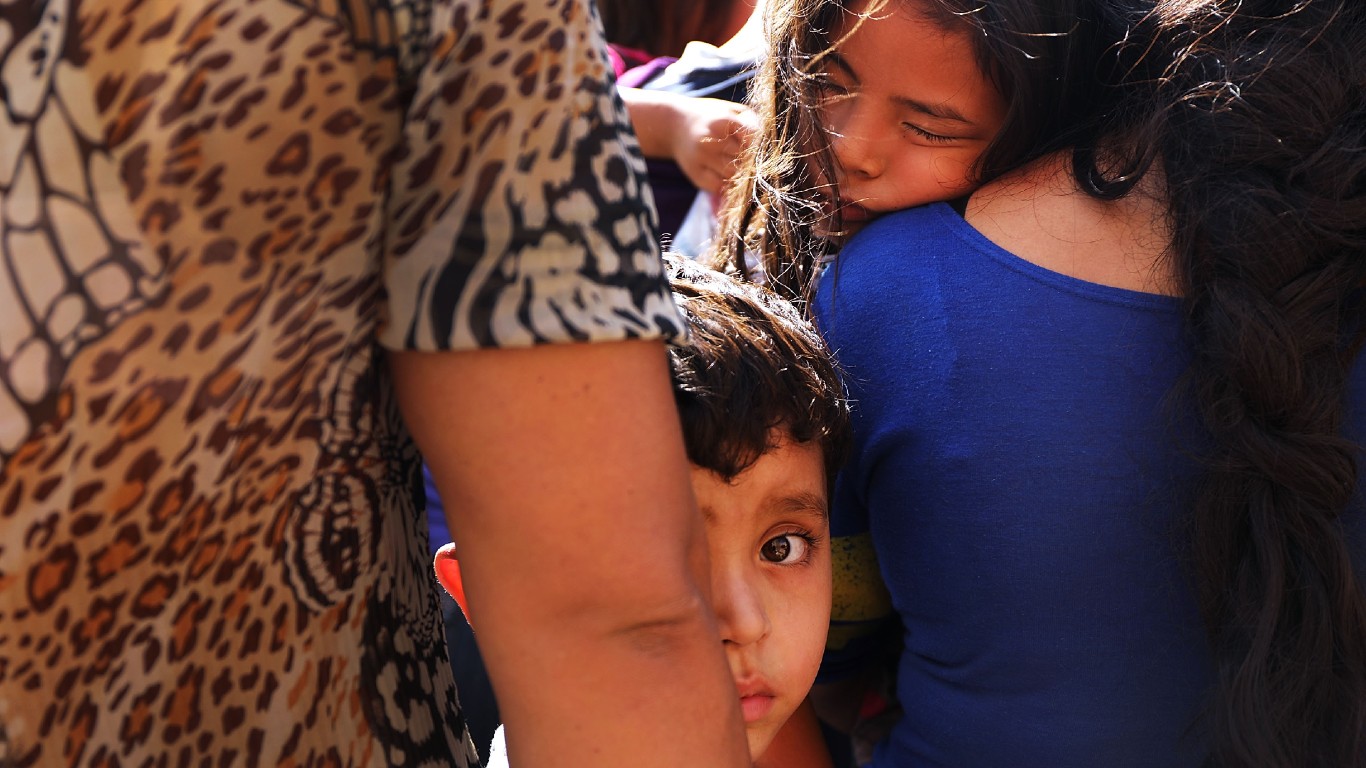
Published:

More than 40 million Americans live below the poverty line – an income threshold of about $35 per day, or $1,073 a month. Of those facing such extreme financial hardship, children are disproportionately affected.
The United States has one of the worst child poverty rates among wealthy, developed countries – and nearly 12.6 million children and youth under age 18 live in households with poverty level incomes. Not only are children at higher risk of poverty, they are also especially vulnerable to poverty’s harmful effects, both in the immediate and long-term.
Childhood poverty can negatively impact brain development and has been linked with a greater likelihood of chronic illness, shorter life expectancy, and poor emotional and behavioral health. Those who spend some or all of their childhood in poverty are also less likely to succeed in school or be financially secure later in life.
Nationwide, an estimated 17.5% of children under age 18 live below the poverty line. This share varies from place to place, however, and in most states, there is at least one major city where child poverty is more common than average. Using data from the U.S. Census Bureau, 24/7 Wall St. identified the metropolitan area in each state with the highest child poverty rate.
It is important to note that in six states – Alaska, Delaware, New Hampshire, Rhode Island, Vermont, and Wyoming – there is only one metro area with available data. As a result, the lone metro area ranks as having the worst child poverty by default only. Among the places on this list, the child poverty rate ranges from about 10% to nearly 40% and in all but a handful of cases, exceeds the overall statewide child poverty rate. Here is a look at the income a family needs to cover normal living expenses in every state.
Children raised in mother-only households are far more likely to live in poverty than those in two-adult households, and in most metro areas on this list, the share of households headed by single mothers exceeds the comparable statewide share.
Families in most metro areas on this list are also more likely to rely on government assistance to afford basic necessities than families in much of the state. The share of households with children receiving SNAP benefits, or food stamps, exceeds the statewide share in all but four metro areas on this list. Here is a look at the cities with the most people on food stamps.
Click here to see the metro area with the highest child poverty rate in every state
Click here to read our detailed methodology

Alabama: Dothan
> Child poverty rate: 27.6% (Alabama: 22.7%)
> Median family income, households with children: $57,611 (Alabama: $64,790)
> Share of households with children receiving SNAP benefits: 26.4% (Alabama: 22.4%)
> Households headed by single mothers: 12.5% (Alabama: 13.3%)
> No. of metros considered in ranking: 12
[in-text-ad]

Alaska: Anchorage
> Child poverty rate: 11.6% (Alaska: 13.8%)
> Median family income, households with children: $93,794 (Alaska: $88,245)
> Share of households with children receiving SNAP benefits: 13.8% (Alaska: 15.9%)
> Households headed by single mothers: 10.1% (Alaska: 10.6%)
> No. of metros considered in ranking: 1
*Because Anchorage is the only eligible metro in Alaska, it is the metro with the highest child poverty rate by default.

Arizona: Yuma
> Child poverty rate: 26.4% (Arizona: 20.0%)
> Median family income, households with children: $51,799 (Arizona: $69,758)
> Share of households with children receiving SNAP benefits: 28.3% (Arizona: 19.3%)
> Households headed by single mothers: 13.9% (Arizona: 11.9%)
> No. of metros considered in ranking: 7

Arkansas: Hot Springs
> Child poverty rate: 28.6% (Arkansas: 22.0%)
> Median family income, households with children: $51,803 (Arkansas: $59,204)
> Share of households with children receiving SNAP benefits: 24.2% (Arkansas: 18.7%)
> Households headed by single mothers: 13.5% (Arkansas: 13.2%)
> No. of metros considered in ranking: 6
[in-text-ad-2]

California: El Centro
> Child poverty rate: 30.3% (California: 16.8%)
> Median family income, households with children: $53,566 (California: $84,790)
> Share of households with children receiving SNAP benefits: 37.3% (California: 16.1%)
> Households headed by single mothers: 15.7% (California: 10.8%)
> No. of metros considered in ranking: 26

Colorado: Pueblo
> Child poverty rate: 25.1% (Colorado: 11.5%)
> Median family income, households with children: $56,652 (Colorado: $91,425)
> Share of households with children receiving SNAP benefits: 29.6% (Colorado: 11.6%)
> Households headed by single mothers: 14.0% (Colorado: 9.0%)
> No. of metros considered in ranking: 7
[in-text-ad]

Connecticut: New Haven-Milford
> Child poverty rate: 15.8% (Connecticut: 13.0%)
> Median family income, households with children: $83,470 (Connecticut: $100,115)
> Share of households with children receiving SNAP benefits: 20.1% (Connecticut: 15.3%)
> Households headed by single mothers: 13.7% (Connecticut: 11.4%)
> No. of metros considered in ranking: 4

Delaware: Dover
> Child poverty rate: 19.8% (Delaware: 17.2%)
> Median family income, households with children: $61,775 (Delaware: $79,268)
> Share of households with children receiving SNAP benefits: 25.1% (Delaware: 19.7%)
> Households headed by single mothers: 15.7% (Delaware: 12.1%)
> No. of metros considered in ranking: 1
*Because Dover is the only eligible metro in Delaware, it is the metro with the highest child poverty rate by default.
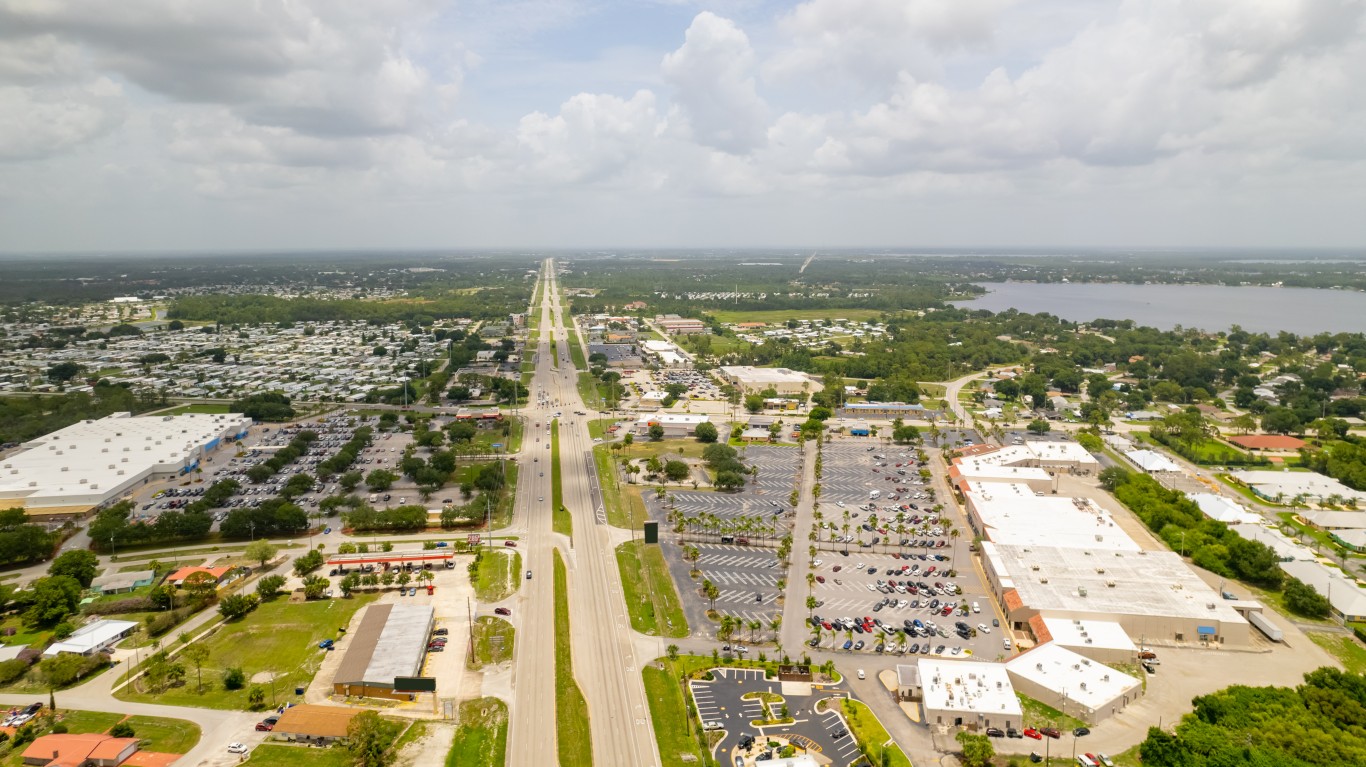
Florida: Sebring-Avon Park
> Child poverty rate: 27.7% (Florida: 18.7%)
> Median family income, households with children: $50,391 (Florida: $65,053)
> Share of households with children receiving SNAP benefits: 27.5% (Florida: 22.7%)
> Households headed by single mothers: 8.9% (Florida: 11.4%)
> No. of metros considered in ranking: 22
[in-text-ad-2]

Georgia: Albany
> Child poverty rate: 34.2% (Georgia: 20.1%)
> Median family income, households with children: $45,841 (Georgia: $70,326)
> Share of households with children receiving SNAP benefits: 35.5% (Georgia: 19.6%)
> Households headed by single mothers: 21.8% (Georgia: 14.3%)
> No. of metros considered in ranking: 14

Hawaii: Urban Honolulu
> Child poverty rate: 10.8% (Hawaii: 11.7%)
> Median family income, households with children: $99,040 (Hawaii: $91,696)
> Share of households with children receiving SNAP benefits: 14.3% (Hawaii: 17.0%)
> Households headed by single mothers: 9.1% (Hawaii: 9.7%)
> No. of metros considered in ranking: 2
[in-text-ad]

Idaho: Twin Falls
> Child poverty rate: 20.9% (Idaho: 14.4%)
> Median family income, households with children: $60,547 (Idaho: $69,851)
> Share of households with children receiving SNAP benefits: 17.2% (Idaho: 15.3%)
> Households headed by single mothers: 9.4% (Idaho: 8.4%)
> No. of metros considered in ranking: 6
Illinois: Danville
> Child poverty rate: 30.5% (Illinois: 16.2%)
> Median family income, households with children: $46,539 (Illinois: $83,907)
> Share of households with children receiving SNAP benefits: 30.7% (Illinois: 19.4%)
> Households headed by single mothers: 16.3% (Illinois: 11.7%)
> No. of metros considered in ranking: 10
Indiana: Michigan City-La Porte
> Child poverty rate: 27.5% (Indiana: 17.6%)
> Median family income, households with children: $63,318 (Indiana: $70,859)
> Share of households with children receiving SNAP benefits: 22.3% (Indiana: 16.0%)
> Households headed by single mothers: 13.6% (Indiana: 12.0%)
> No. of metros considered in ranking: 12
[in-text-ad-2]

Iowa: Davenport-Moline-Rock Island
> Child poverty rate: 19.1% (Iowa: 13.3%)
> Median family income, households with children: $73,779 (Iowa: $79,139)
> Share of households with children receiving SNAP benefits: 20.4% (Iowa: 16.7%)
> Households headed by single mothers: 12.3% (Iowa: 10.3%)
> No. of metros considered in ranking: 8
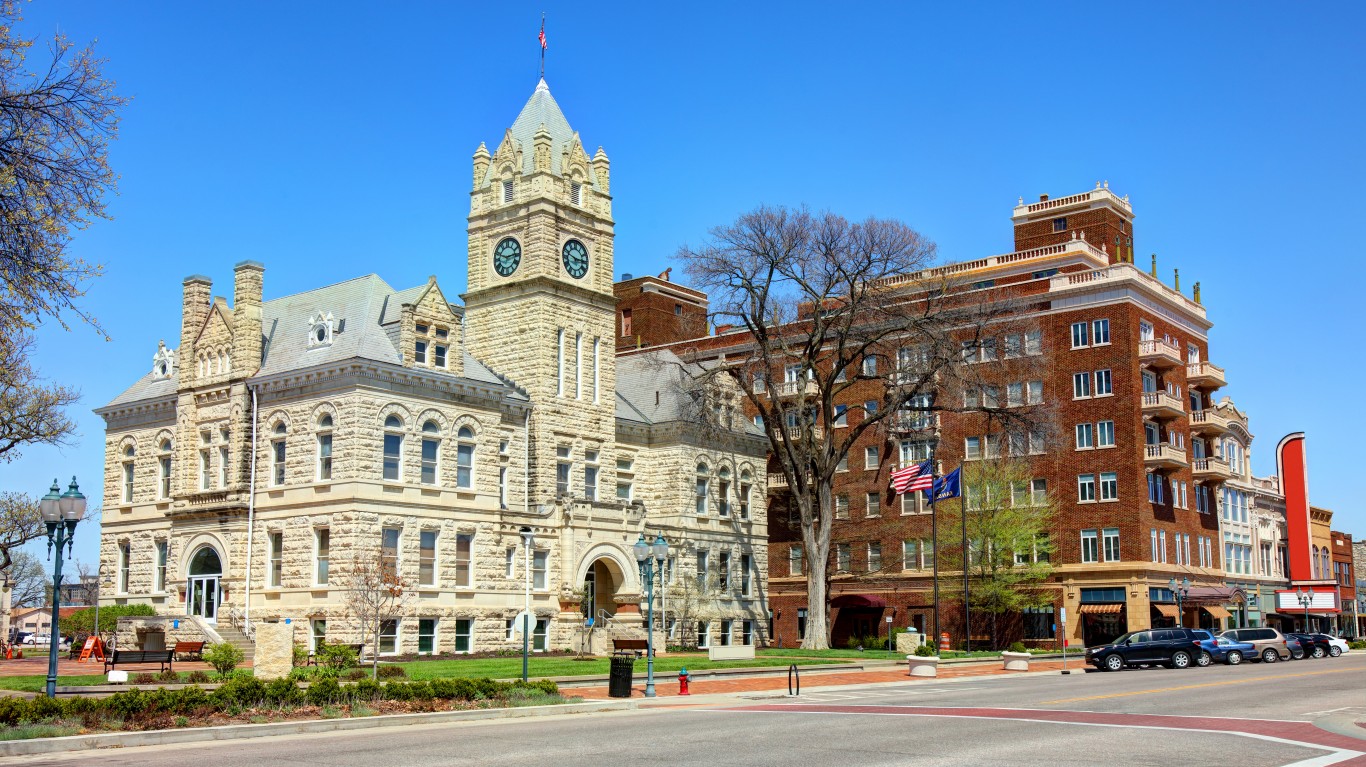
Kansas: Manhattan
> Child poverty rate: 17.1% (Kansas: 13.9%)
> Median family income, households with children: $61,228 (Kansas: $74,882)
> Share of households with children receiving SNAP benefits: 13.5% (Kansas: 11.6%)
> Households headed by single mothers: 11.8% (Kansas: 10.4%)
> No. of metros considered in ranking: 4
[in-text-ad]

Kentucky: Bowling Green
> Child poverty rate: 22.5% (Kentucky: 22.2%)
> Median family income, households with children: $57,593 (Kentucky: $65,096)
> Share of households with children receiving SNAP benefits: 23.4% (Kentucky: 20.8%)
> Households headed by single mothers: 12.3% (Kentucky: 12.2%)
> No. of metros considered in ranking: 5

Louisiana: Monroe
> Child poverty rate: 35.4% (Louisiana: 26.3%)
> Median family income, households with children: $49,579 (Louisiana: $61,722)
> Share of households with children receiving SNAP benefits: 29.4% (Louisiana: 24.9%)
> Households headed by single mothers: 17.7% (Louisiana: 16.0%)
> No. of metros considered in ranking: 9

Maine: Bangor
> Child poverty rate: 16.0% (Maine: 14.0%)
> Median family income, households with children: $67,330 (Maine: $76,852)
> Share of households with children receiving SNAP benefits: 22.1% (Maine: 18.4%)
> Households headed by single mothers: 10.1% (Maine: 9.1%)
> No. of metros considered in ranking: 3
[in-text-ad-2]

Maryland: Salisbury
> Child poverty rate: 21.2% (Maryland: 11.6%)
> Median family income, households with children: $64,803 (Maryland: $103,641)
> Share of households with children receiving SNAP benefits: 26.1% (Maryland: 15.5%)
> Households headed by single mothers: 11.6% (Maryland: 12.2%)
> No. of metros considered in ranking: 4

Massachusetts: Springfield
> Child poverty rate: 20.1% (Massachusetts: 12.2%)
> Median family income, households with children: $75,202 (Massachusetts: $109,908)
> Share of households with children receiving SNAP benefits: 26.0% (Massachusetts: 15.8%)
> Households headed by single mothers: 15.1% (Massachusetts: 11.1%)
> No. of metros considered in ranking: 5
[in-text-ad]

Michigan: Battle Creek
> Child poverty rate: 26.6% (Michigan: 18.8%)
> Median family income, households with children: $58,354 (Michigan: $73,187)
> Share of households with children receiving SNAP benefits: 18.9% (Michigan: 19.7%)
> Households headed by single mothers: 14.9% (Michigan: 11.5%)
> No. of metros considered in ranking: 14

Minnesota: Duluth
> Child poverty rate: 13.8% (Minnesota: 11.6%)
> Median family income, households with children: $79,437 (Minnesota: $95,628)
> Share of households with children receiving SNAP benefits: 15.0% (Minnesota: 11.6%)
> Households headed by single mothers: 10.2% (Minnesota: 9.8%)
> No. of metros considered in ranking: 5

Mississippi: Hattiesburg
> Child poverty rate: 30.3% (Mississippi: 27.6%)
> Median family income, households with children: $56,265 (Mississippi: $54,822)
> Share of households with children receiving SNAP benefits: 26.6% (Mississippi: 24.2%)
> Households headed by single mothers: 16.4% (Mississippi: 16.8%)
> No. of metros considered in ranking: 3
[in-text-ad-2]

Missouri: Joplin
> Child poverty rate: 22.8% (Missouri: 17.4%)
> Median family income, households with children: $54,030 (Missouri: $72,033)
> Share of households with children receiving SNAP benefits: 25.0% (Missouri: 17.2%)
> Households headed by single mothers: 11.2% (Missouri: 11.5%)
> No. of metros considered in ranking: 8

Montana: Great Falls
> Child poverty rate: 16.2% (Montana: 15.2%)
> Median family income, households with children: $60,193 (Montana: $71,986)
> Share of households with children receiving SNAP benefits: 19.3% (Montana: 16.2%)
> Households headed by single mothers: 11.4% (Montana: 8.4%)
> No. of metros considered in ranking: 3
[in-text-ad]

Nebraska: Grand Island
> Child poverty rate: 15.1% (Nebraska: 12.2%)
> Median family income, households with children: $62,614 (Nebraska: $77,982)
> Share of households with children receiving SNAP benefits: 17.5% (Nebraska: 13.9%)
> Households headed by single mothers: 15.1% (Nebraska: 10.4%)
> No. of metros considered in ranking: 3

Nevada: Las Vegas-Henderson-Paradise
> Child poverty rate: 18.7% (Nevada: 17.6%)
> Median family income, households with children: $65,284 (Nevada: $67,738)
> Share of households with children receiving SNAP benefits: 19.9% (Nevada: 18.7%)
> Households headed by single mothers: 13.8% (Nevada: 12.8%)
> No. of metros considered in ranking: 2

New Hampshire: Manchester-Nashua
> Child poverty rate: 9.9% (New Hampshire: 8.9%)
> Median family income, households with children: $103,297 (New Hampshire: $100,798)
> Share of households with children receiving SNAP benefits: 12.1% (New Hampshire: 11.3%)
> Households headed by single mothers: 9.1% (New Hampshire: 8.2%)
> No. of metros considered in ranking: 1
*Because Manchester-Nashua is the only eligible metro in New Hampshire, it is the metro with the highest child poverty rate by default.
[in-text-ad-2]

New Jersey: Vineland-Bridgeton
> Child poverty rate: 22.0% (New Jersey: 13.3%)
> Median family income, households with children: $55,359 (New Jersey: $106,937)
> Share of households with children receiving SNAP benefits: 25.7% (New Jersey: 12.6%)
> Households headed by single mothers: 16.7% (New Jersey: 10.3%)
> No. of metros considered in ranking: 3
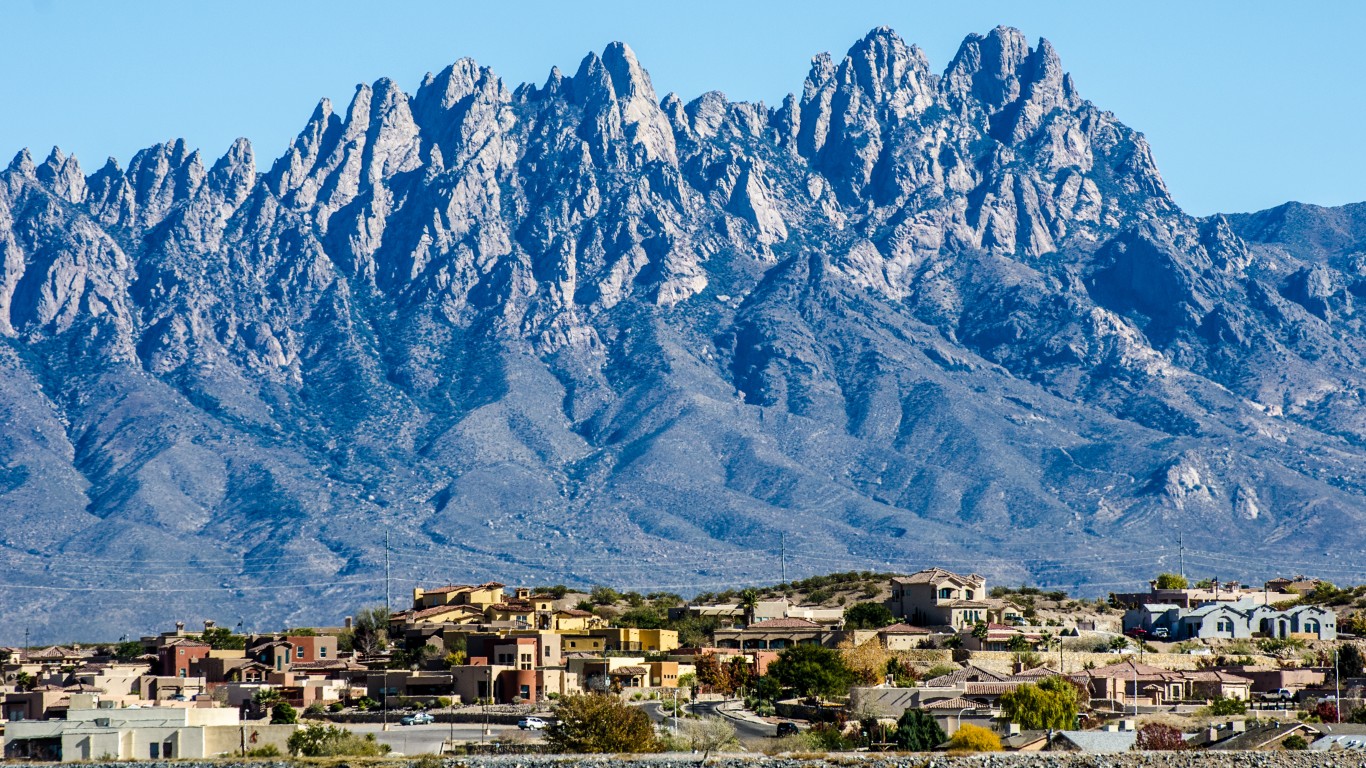
New Mexico: Las Cruces
> Child poverty rate: 34.7% (New Mexico: 25.6%)
> Median family income, households with children: $43,555 (New Mexico: $54,886)
> Share of households with children receiving SNAP benefits: 37.3% (New Mexico: 28.4%)
> Households headed by single mothers: 14.9% (New Mexico: 14.0%)
> No. of metros considered in ranking: 4
[in-text-ad]

New York: Binghamton
> Child poverty rate: 22.3% (New York: 18.7%)
> Median family income, households with children: $62,829 (New York: $83,272)
> Share of households with children receiving SNAP benefits: 25.0% (New York: 19.4%)
> Households headed by single mothers: 12.0% (New York: 12.4%)
> No. of metros considered in ranking: 13
North Carolina: Goldsboro
> Child poverty rate: 30.3% (North Carolina: 20.0%)
> Median family income, households with children: $48,333 (North Carolina: $68,688)
> Share of households with children receiving SNAP benefits: 28.5% (North Carolina: 20.0%)
> Households headed by single mothers: 15.7% (North Carolina: 12.5%)
> No. of metros considered in ranking: 15

North Dakota: Grand Forks
> Child poverty rate: 13.7% (North Dakota: 11.1%)
> Median family income, households with children: $82,943 (North Dakota: $86,414)
> Share of households with children receiving SNAP benefits: 14.9% (North Dakota: 10.9%)
> Households headed by single mothers: 11.5% (North Dakota: 9.2%)
> No. of metros considered in ranking: 3
[in-text-ad-2]
Ohio: Youngstown-Warren-Boardman
> Child poverty rate: 27.7% (Ohio: 19.1%)
> Median family income, households with children: $57,485 (Ohio: $72,130)
> Share of households with children receiving SNAP benefits: 28.9% (Ohio: 19.8%)
> Households headed by single mothers: 13.5% (Ohio: 12.8%)
> No. of metros considered in ranking: 11

Oklahoma: Lawton
> Child poverty rate: 22.3% (Oklahoma: 20.7%)
> Median family income, households with children: $52,662 (Oklahoma: $62,535)
> Share of households with children receiving SNAP benefits: 22.7% (Oklahoma: 20.6%)
> Households headed by single mothers: 16.9% (Oklahoma: 12.5%)
> No. of metros considered in ranking: 4
[in-text-ad]
Oregon: Grants Pass
> Child poverty rate: 19.9% (Oregon: 15.0%)
> Median family income, households with children: $53,978 (Oregon: $78,939)
> Share of households with children receiving SNAP benefits: 34.5% (Oregon: 21.6%)
> Households headed by single mothers: 8.5% (Oregon: 9.9%)
> No. of metros considered in ranking: 8

Pennsylvania: Scranton-Wilkes-Barre
> Child poverty rate: 23.1% (Pennsylvania: 16.7%)
> Median family income, households with children: $63,227 (Pennsylvania: $81,257)
> Share of households with children receiving SNAP benefits: 28.3% (Pennsylvania: 20.3%)
> Households headed by single mothers: 13.3% (Pennsylvania: 11.1%)
> No. of metros considered in ranking: 18

Rhode Island: Providence-Warwick
> Child poverty rate: 15.5% (Rhode Island: 15.6%)
> Median family income, households with children: $84,422 (Rhode Island: $83,161)
> Share of households with children receiving SNAP benefits: 21.5% (Rhode Island: 21.0%)
> Households headed by single mothers: 13.1% (Rhode Island: 12.5%)
> No. of metros considered in ranking: 1
*Because Providence-Warwick is the only eligible metro in Rhode Island, it is the metro with the highest child poverty rate by default.
[in-text-ad-2]

South Carolina: Sumter
> Child poverty rate: 27.5% (South Carolina: 21.2%)
> Median family income, households with children: $48,688 (South Carolina: $64,942)
> Share of households with children receiving SNAP benefits: 28.0% (South Carolina: 20.0%)
> Households headed by single mothers: 16.7% (South Carolina: 13.4%)
> No. of metros considered in ranking: 8

South Dakota: Rapid City
> Child poverty rate: 17.6% (South Dakota: 16.1%)
> Median family income, households with children: $71,506 (South Dakota: $76,789)
> Share of households with children receiving SNAP benefits: 17.5% (South Dakota: 15.8%)
> Households headed by single mothers: 10.8% (South Dakota: 10.3%)
> No. of metros considered in ranking: 2
[in-text-ad]

Tennessee: Memphis
> Child poverty rate: 27.2% (Tennessee: 20.8%)
> Median family income, households with children: $59,762 (Tennessee: $65,852)
> Share of households with children receiving SNAP benefits: 24.4% (Tennessee: 20.9%)
> Households headed by single mothers: 18.5% (Tennessee: 12.4%)
> No. of metros considered in ranking: 10
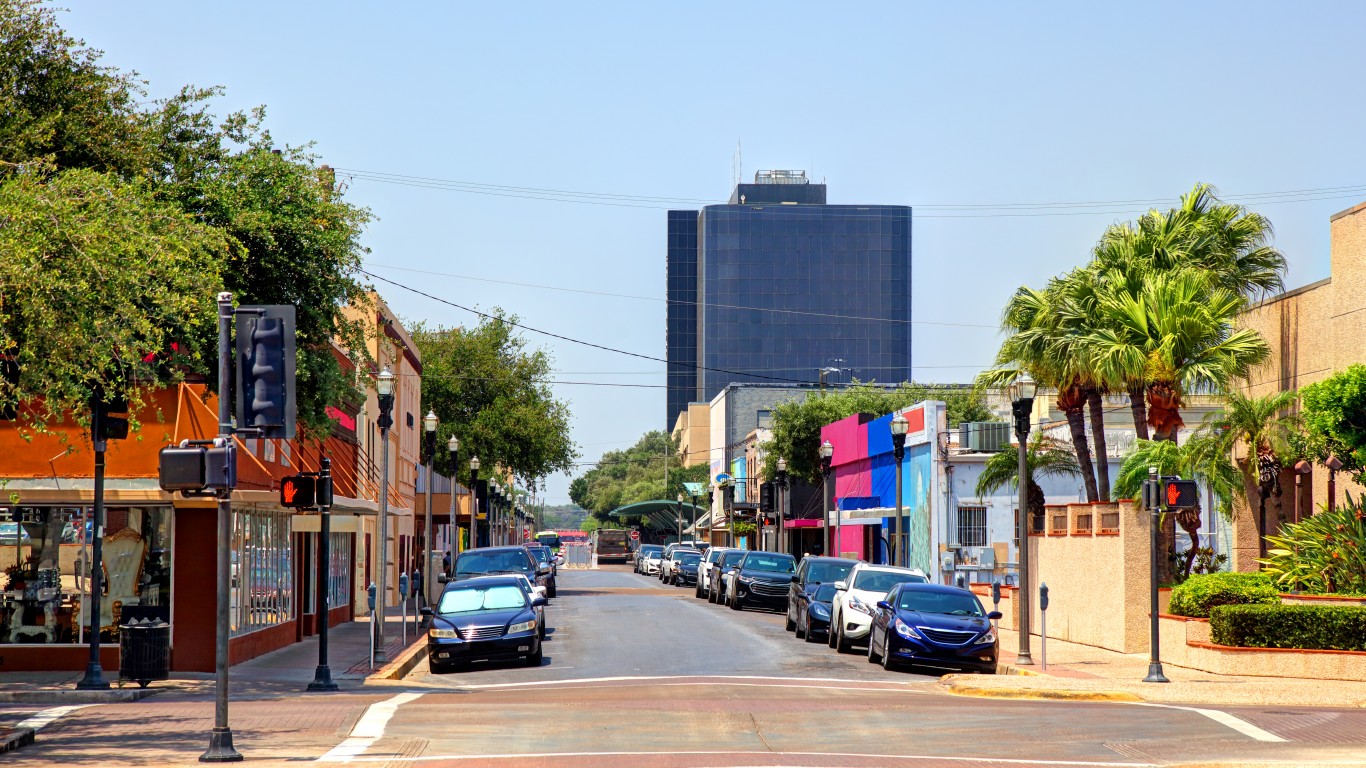
Texas: McAllen-Edinburg-Mission
> Child poverty rate: 39.6% (Texas: 20.0%)
> Median family income, households with children: $41,938 (Texas: $71,693)
> Share of households with children receiving SNAP benefits: 39.3% (Texas: 19.3%)
> Households headed by single mothers: 18.6% (Texas: 13.2%)
> No. of metros considered in ranking: 25

Utah: Logan
> Child poverty rate: 14.7% (Utah: 9.9%)
> Median family income, households with children: $69,649 (Utah: $84,298)
> Share of households with children receiving SNAP benefits: 11.9% (Utah: 9.4%)
> Households headed by single mothers: 7.0% (Utah: 7.7%)
> No. of metros considered in ranking: 5
[in-text-ad-2]

Vermont: Burlington-South Burlington
> Child poverty rate: 9.6% (Vermont: 12.3%)
> Median family income, households with children: $98,361 (Vermont: $81,902)
> Share of households with children receiving SNAP benefits: 10.1% (Vermont: 15.2%)
> Households headed by single mothers: 8.6% (Vermont: 9.5%)
> No. of metros considered in ranking: 1
*Because Burlington-South Burlington is the only eligible metro in Vermont, it is the metro with the highest child poverty rate by default.

Virginia: Roanoke
> Child poverty rate: 18.3% (Virginia: 13.1%)
> Median family income, households with children: $68,533 (Virginia: $93,828)
> Share of households with children receiving SNAP benefits: 19.1% (Virginia: 13.1%)
> Households headed by single mothers: 11.8% (Virginia: 10.8%)
> No. of metros considered in ranking: 9
[in-text-ad]

Washington: Yakima
> Child poverty rate: 23.0% (Washington: 12.6%)
> Median family income, households with children: $54,097 (Washington: $90,447)
> Share of households with children receiving SNAP benefits: 32.4% (Washington: 16.0%)
> Households headed by single mothers: 15.2% (Washington: 9.4%)
> No. of metros considered in ranking: 11
West Virginia: Beckley
> Child poverty rate: 30.6% (West Virginia: 23.1%)
> Median family income, households with children: $52,536 (West Virginia: $59,938)
> Share of households with children receiving SNAP benefits: 31.0% (West Virginia: 26.8%)
> Households headed by single mothers: 11.4% (West Virginia: 10.3%)
> No. of metros considered in ranking: 7

Wisconsin: Racine
> Child poverty rate: 18.8% (Wisconsin: 14.2%)
> Median family income, households with children: $69,916 (Wisconsin: $81,197)
> Share of households with children receiving SNAP benefits: 24.7% (Wisconsin: 16.6%)
> Households headed by single mothers: 13.2% (Wisconsin: 10.2%)
> No. of metros considered in ranking: 11
[in-text-ad-2]

Wyoming: Casper
> Child poverty rate: 10.9% (Wyoming: 12.3%)
> Median family income, households with children: $70,803 (Wyoming: $80,825)
> Share of households with children receiving SNAP benefits: 12.4% (Wyoming: 9.2%)
> Households headed by single mothers: 13.1% (Wyoming: 8.7%)
> No. of metros considered in ranking: 1
*Because Casper is the only eligible metro in Wyoming, it is the metro with the highest child poverty rate by default.
Methodology
To determine the metro area with the highest child poverty rate in every state, 24/7 Wall St. reviewed five-year estimates of child poverty rates from the U.S. Census Bureau’s 2020 American Community Survey.
We used the 384 metropolitan statistical areas as delineated by the United States Office of Management and Budget and used by the Census Bureau as our definition of metros.
Metro areas were excluded if the child poverty rate was not available in the 2020 ACS, if the number of children for whom poverty status was determined was lower than 500, or if the sampling error associated with a metro area’s data was deemed too high.
The sampling error was defined as too high if the coefficient of variation — a statistical assessment of how reliable an estimate is — for a metro area’s child poverty rate was above 15% and greater than two standard deviations above the mean CV for all metro areas’ child poverty rates. We similarly excluded metro areas that had a sampling error too high for their population, using the same definition.
Metro areas were ranked based on the share of children living in poverty. To break ties, we used the number of children living in poverty.
Additional information on median income for families with children, the share of households with children receiving benefits from the Supplemental Nutrition Assistance Program, and the share of households headed by single mothers are also five-year estimates from the 2020 ACS. Because the Census Bureau didn’t release one-year estimates for 2020 due to data collection issues caused by the COVID-19 pandemic, all ACS data are five-year estimates.
Credit card companies are at war, handing out free rewards and benefits to win the best customers. A good cash back card can be worth thousands of dollars a year in free money, not to mention other perks like travel, insurance, and access to fancy lounges. See our top picks for the best credit cards today. You won’t want to miss some of these offers.
Flywheel Publishing has partnered with CardRatings for our coverage of credit card products. Flywheel Publishing and CardRatings may receive a commission from card issuers.
Thank you for reading! Have some feedback for us?
Contact the 24/7 Wall St. editorial team.